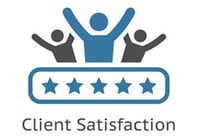 As a business owner, one thing that keeps me awake at night is how to achieve unprecedented levels of client satisfaction. We study it. We regularly train on it. We preach it at company-wide meetings. And we consistently perform above average on our client satisfaction ratings, yet, we always strive to do better for our clients.
As a business owner, one thing that keeps me awake at night is how to achieve unprecedented levels of client satisfaction. We study it. We regularly train on it. We preach it at company-wide meetings. And we consistently perform above average on our client satisfaction ratings, yet, we always strive to do better for our clients.
We want our clients to be so satisfied that they are fiercely loyal to our brand and what we provide. Isn’t that what every business wants?
Here are six keys we’ve found to achieving unprecedented levels of client satisfaction:
1. Define It
Know what customer satisfaction looks like in your business and specifically define what factors contribute to your customer’s happiness.
For healthcare practices, patient satisfaction is often indicated by wait time, provider communication and staff helpfulness. At Netgain, our clients identify courtesy, timeliness and knowledge as the most important aspects of their experience. We measure these indicators with surveys to our clients on a regular basis and communicate this with our team and clients.
2. Know your Numbers
Customer satisfaction looks different in every industry, but they all have benchmarks on exceptional, average and low performance that you can use to assess your organization.
At Netgain, our client satisfaction is defined by the Net Promotor Score (NPS) – an industry standard that gauges the loyalty of a customer relationship. Clients are regularly asked the question: How likely is it that you would recommend Netgain to a friend or colleague? This NPS question is the most important indication of loyalty, in our minds.
In the technology sector, the average NPS score is 35. Netgain has consistently outperformed the national average and currently has a score of 61. We work very hard to be a service provider that our customers are proud to promote.
3. Engage Employees
This is perhaps the most important key to customer satisfaction. Without including your employees, all the studying and measuring in the world won’t be effective. Happy, engaged employees provide better service. Period.
Employee engagement comes in many forms from formal training and personal development to incentives and competitions. Determine what works best for your team and invest time and resources in it. It’ll pay off not only with customer satisfaction, but also employee satisfaction. Everyone wins.
4. Ask and Act
A study by InfoQuest recently revealed that a “totally satisfied customer” contributes 2.6 times as much revenue to a company as a “somewhat satisfied customer.” Are you regularly asking your customers or patients how you’re doing?
Identify how frequently customers should be surveyed and what questions matter to your business.
Acting upon customer feedback – good or bad - is the most important piece of the survey process. Follow up with customers letting them know you appreciate their feedback and if possible, tell them what your business will change based on their feedback. This ensures the customer feels heard and valued.
Netgain partners with Helpdesk Institute (HDI) to send surveys to clients after each support ticket request. This survey includes the four most important customer satisfaction indicators and the NPS question. We review survey results and address any comments noted or scores that fall below a certain threshold.
On a scale of 1-5, our most recent HDI scores are:
• Average of Courtesy: 4.90
• Average of Timeliness: 4.81
• Average of Knowledge: 4.79
• Average of Quality: 4.84
• Average of Overall: 4.81
5.Make it Personal
Whenever possible, connect customers with real people. When customers get to speak with real people, rather than a pre-recorded voice, it adds credibility to your brand and creates an emotional connection.
Start by listing all the ways a customer interacts with your brand – phone, in-person, website, etc. Now identify how quickly they have access to a real person via this channel. Reduce their time spent in an automated phone system, place a real person at the reception desk or maybe a chat option on your website.
Netgain has implemented Client Support Teams (CST) that are dedicated to specific clients based on what EHR they use and what their sub-specialty is. Clients experience a more personal connection with their support staff, more specialized service and shorter wait times thanks to CSTs.
6. Be Consistent
Provide an experience where customers know what to expect. Being consistent builds trust. Identify which parts of your customer’s journey matter most to them and aim to provide consistent experiences in those areas.
Think of your favorite hotel. If you stayed there five separate times and only three of those times your room was clean, would you be likely to recommend it to a friend or visit the hotel again? Not as likely as if the room was consistently clean, right?
Netgain has both people and technology procedures in place to ensure customers have a consistent experience when they reach out to us. Our abovementioned Client Support Teams are one example of how we provide consistency in the people and level of experience that clients receive when requesting support.
Customer satisfaction is at the center of every service-based organization. Your customers aren’t the only ones that benefit from your investment in customer satisfaction. Your business gains valuable insight, too. Netgain’s commitment to customer service has also helped us:
• Indicate and forecast renewal intentions
• Differentiate our business from competitors
• Reduce customer churn
• Increase customer lifetime value
• Increase word-of-mouth referrals
Do you have any customer satisfaction tips that have worked for your practice?
 Support
Support Contact Us
Contact Us



